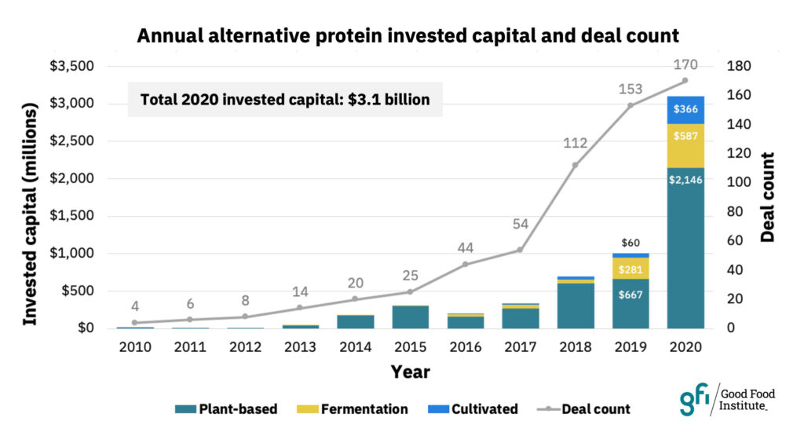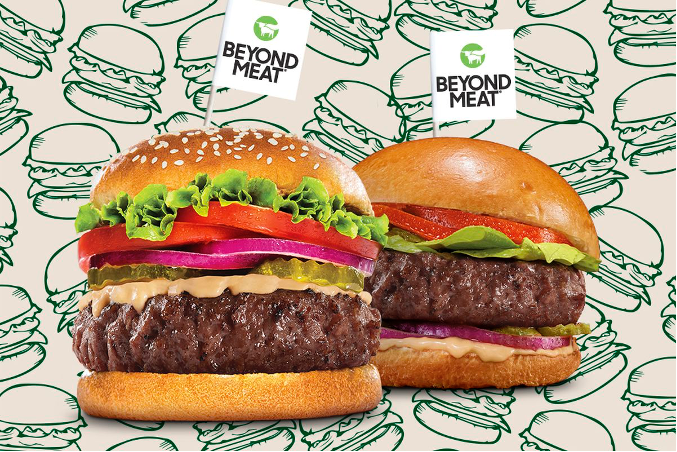How Alternative Proteins Help to Solve Environmental Challenges
August 3, 2021
With the impacts of climate change being at an all-time high, the alternative protein industry needs to play a role in mitigating the environmental impacts of the global demand for protein in order to transition to a low carbon society.
According to the EPA, the agriculture sector is responsible for 10% of the total greenhouse gases emitted in the United States in 2019. The alternative protein industry has the potential to reduce the greenhouse gas emissions from the agriculture industry by providing an alternative to meat. With an increase in consumer demand for alternative proteins, there is room for growth in the alt protein space. According to the Good Food Institute, there was record breaking funding for alt protein in 2020. There were more investments in 2020 than in any single year in the industry’s history, even despite the ongoing pandemic as seen in the graph below.

Basics of Alternative Protein
The three main categories of alt protein include plant-based, cultivated, and fermentation-derived alternatives to conventional meat, egg, and dairy products. The Good Food Institute (GFI) refers to “plant-based” as products made from plants that are alternatives to animal-based products. This includes products such as Just Egg, which is made from the protein-rich legume called the mung bean, the Beyond Burger, made from a variety of plant proteins, and many more products produced using a variety of plants.

Cultivated meat, which is also known as cultured meat, is produced by growing animal cells in a cell culture instead of in an animal’s body. By using this method to produce products, the need for traditional animal agriculture is eliminated. Cultivated meat is able to replicate the same sensory and nutritional makeup of traditional meat because it is produced using the same cell types arranged in the same or similar structure as animal tissues. According to GFI, life cycle assessments show that cultivated meat will lead to a low-carbon society, through the use of less land and water, emission of fewer greenhouse gases, and reduction of traditional animal agriculture related pollution and eutrophication.
The process of fermentation is not a new concept, and ancient civilizations have been utilizing the process to make food and beverages for millennia. The fermentation-derived products within the alternative protein space uses three types of fermentation. Traditional fermentation uses intact live microorganisms to modify and process plant-derived inputs. One main example of traditional fermentation in the alt protein industry is tempeh. The fungus Rhizopus is used to ferment soybeans. In addition to traditional fermentation, there is biomass fermentation, which utilizes intact or minimally processed microbial biomass as an ingredient to efficiently produce large quantities of protein. One example of biomass fermentation is Quorn’s filamentous fungi which is used as the base for their products. The final type of fermentation in the alt protein industry is precision fermentation which uses microbial hosts as “cell factories” for producing specific functional ingredients. Precision fermentation produces a variety of ingredients including enzymes, vitamins, fats, etc. An example of ingredients produced via precision fermentation is Perfect Day’s animal free dairy protein.
Consumer Perception
In order to be successful in transitioning to a low-carbon economy, there needs to be a special focus on consumer perception of alt protein products. Alt protein products are not only developed with a focus on vegans and vegetarians anymore. There is a focus on omnivores, where consumers eat both alternatives and conventional meat, eggs, and dairy products. Since alt proteins are developed with omnivores in mind, producers are creating products that mimic animal-based products. According to GFI, food manufacturers should focus primarily on the taste of their products, over other challenges such as the price, in order win over consumers. Even though there are upward trends in the consumption of alternative protein products, there is still room to grow and improve.
Environmental Benefits of Alt Protein
Consumers have been making changes to their diet not only based on health, but also environmental impact. The agriculture sector is a large contributor to greenhouse gas emissions and eating a plant-based diet is one way to significantly reduce those emissions. Transitioning away from an animal-based diet “could add up to 49% to the global food supply without expanding croplands” in addition to reducing the consumption of water in some regions (Jalava et al., 2014). According to Blue Horizon, the environmental impact of plant-based products has proven to be significantly lower than the animal-based product, with beef at a 15x, chicken at a 5.5x, pork at a 3.4x, and egg at a 3x lower impact than conventionally farmed products. There are clear upsides to eating a diet consisting of alternative proteins, and in order to increase the market share of these products manufacturers will need to continue driving the price down and improving the taste in order to reach a larger number of consumers.
Overall, the alternative protein industry has the potential to significantly reduce the environmental impacts of traditional animal agriculture, but the industry has work to do in order to increase its consumer base and create more successful products.
Sources:
Alternative proteins: The race for market share is on. (2016, August 16). Retrieved from https://www.mckinsey.com/industries/agriculture/our-insights/alternative-proteins-the-race-for-market-share-is-on
Jalava M, Kummu M, Porkka M, Siebert S, and Varis O (2014). Diet Change–a solution to reduce water use? Environ. Res. lett. 9(7):1-14.
Record $3.1 billion invested in alt proteins in 2020 signals growing market momentum for sustainable proteins. (2021, March 18). Retrieved from https://gfi.org/blog/2020-state-of-the-industry-highlights/
Review and gap-analysis of LCA-studies of cultured meat for The Good Food Institute. (2019, May 22). Retrieved from https://gfi.org/wp-content/uploads/2021/02/Cultivated-Meat-LCA-Report-2019-0709.pdf
Sources of Greenhouse Gas Emissions. Retrieved from
The science of cultivated meat. Retrieved from https://gfi.org/science/the-science-of-cultivated-meat/
The science of fermentation. Retrieved from https://gfi.org/science/the-science-of-fermentation/
The science of plant-based meat. Retrieved from https://gfi.org/science/the-science-of-plant-based-meat/
Up to 15 times lower environmental impact – Study quantifies game changing environmental effect if animal food is replaced by plant-based alternatives. (2020, October 22). Retrieved from https://www.bluehorizon.com/up-to-15-times-lower-environmental-impact-study-quantifies-game-changing-environmental-effect-if-animal-food-is-replaced-by-plant-based-alternatives/
About the Author
This article was written by Hannah Matthews, Cleantech Corner Intern and Environmental Health Sciences BSPH, Class of 2023.
